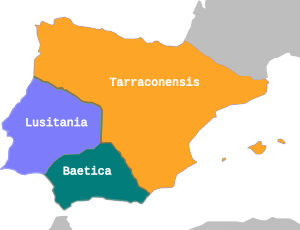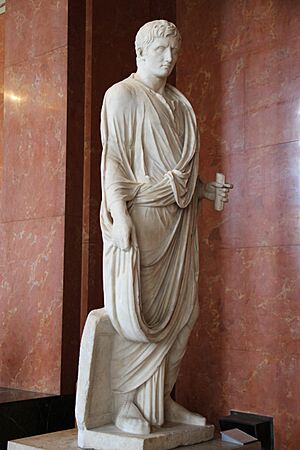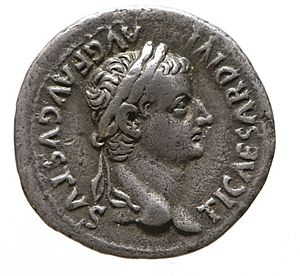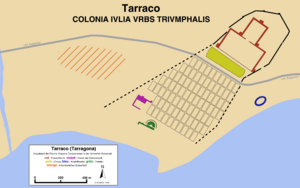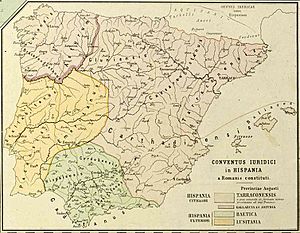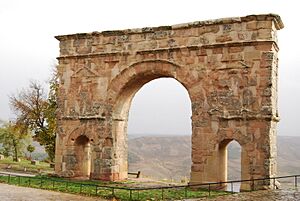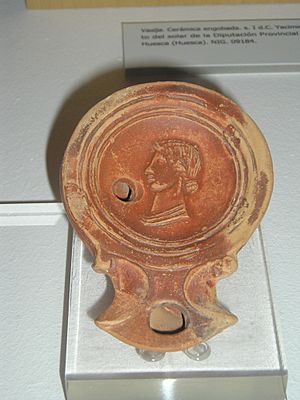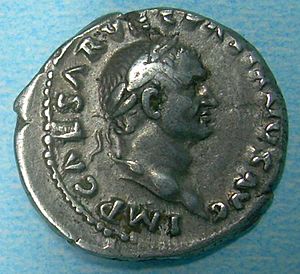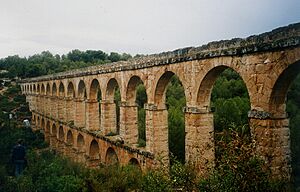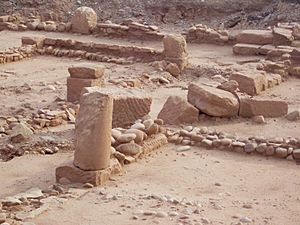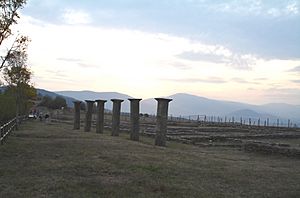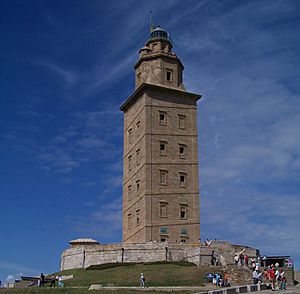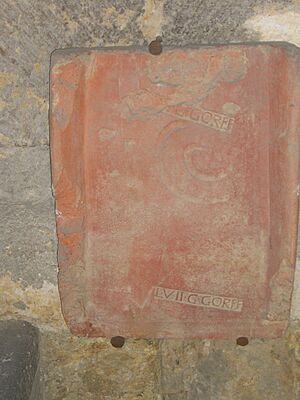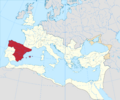Hispania Tarraconensis facts for kids
Quick facts for kids Provincia Hispania Tarraconensis |
|||||||||||
|---|---|---|---|---|---|---|---|---|---|---|---|
| Province of the Roman Empire | |||||||||||
| 27 BC–459 | |||||||||||
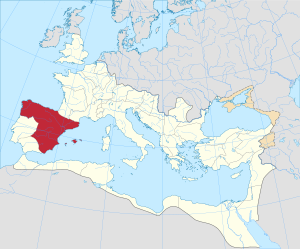 |
|||||||||||
| Capital | Tarraco | ||||||||||
| Historical era | Antiquity | ||||||||||
|
• Established
|
27 BC | ||||||||||
|
• Visigothic conquest
|
459 | ||||||||||
|
|||||||||||
| Today part of | Spain Portugal |
||||||||||
Hispania Tarraconensis was a large and important Roman province in ancient Hispania (which is mostly modern-day Spain and Portugal). It covered a huge part of what is now northern, eastern, and central Spain, plus northern Portugal.
This province was one of three Roman areas in Hispania. To its south was Hispania Baetica, and to its west, along the Atlantic coast, was Lusitania.
Contents
History of Tarraconensis
How the Province Began
Long ago, between the 8th and 6th centuries BC, people from Phoenicia and Carthage settled along the Mediterranean coast of Iberia. Later, the Greeks also set up colonies there. The Romans arrived much later, around the 2nd century BC, during a big war called the Second Punic War.
The province of Hispania Tarraconensis was officially created in 27 BC by Emperor Augustus. It took over from an older Roman area called Hispania Citerior. Augustus divided Hispania into three new provinces to help control the northwestern parts of the peninsula, where groups like the Gallaeci, Cantabri, and Astures lived.
Augustus himself stayed in the region for a while, from 27 to 26 BC, in places like Segisama and Tarraco. His nephew Marcellus and stepson Tiberius (who later became emperor) also gained their first military experience here.
The province was named after its capital city, Colonia Urbs Triumphalis Tarraco, which is now Tarragona. The borders of the province changed in 12 BC. This change brought all Roman troops in Hispania under one command. It also put the main mining areas, which produced valuable gold and silver, under the direct control of the Roman Empire.
Peace and Roman Ways
Emperor Augustus worked to make the province peaceful and more Roman. He gave many towns special status as colonia or municipium. This meant they had Roman rights and laws. This policy was continued by later emperors like Tiberius.
The Romans also built new roads, which helped spread Roman culture and the Latin language. Latin quickly became the common language in the province. People started using Roman money and trading more.
The province was mostly peaceful. Any small rebellions were quickly stopped. Because of this peace, the number of Roman soldiers stationed there was gradually reduced.
In AD 68, Galba, who was the governor of Tarraconensis, decided to rebel against Emperor Nero. He declared himself emperor in the city of Clunia. After gathering support and more soldiers, he marched to Rome to take power.
Later, Emperor Vespasian made a big change around AD 74. He allowed many towns in the province to become municipia with Latin rights. This meant their citizens gained certain Roman legal benefits. Vespasian also kept a smaller army in the province. These soldiers mainly helped the governor, kept order, and watched over the important mining operations.
Hispania Tarraconensis remained a Roman province until the 5th century AD. Around 409 AD, groups like the Suebi, Vandals, and Alans invaded. This led to the end of Roman rule and the start of the Visigothic kingdom.
Mining for Gold and Silver
The Roman province of Tarraconensis was very rich in metals like gold, tin, and silver. The Romans used amazing engineering to get these metals. For example, at Las Medulas, they built long aqueducts, some up to 30 miles (48 km) long, to bring water from the mountains.
They used a method called hydraulic mining (or Ruina montium). This involved sending fast streams of water onto soft rocks to wash away large amounts of gold. When the surface gold was gone, they dug tunnels underground. They even used fire-setting to break up harder rocks. Pliny the Elder, a Roman writer who worked in Tarraconensis, wrote about these clever mining methods.
Geography and Government
Province Size and Borders
At its largest, Hispania Tarraconensis covered about two-thirds of the Iberian Peninsula. The Pyrenees mountains in the north formed its border with Gaul (modern France). To the southwest, its border with Lusitania ran along the Douro and Tormes rivers. The border with Baetica was in the south, near cities like Castulo and Acci.
Tarraconensis was a huge province, covering about 380,000 square kilometers. It had an estimated population of 3 to 3.5 million people. This made it one of the largest provinces in the entire Roman Empire when it was created.
How the Province was Governed
Tarraconensis was an "Imperial province," meaning it was directly controlled by the Emperor. It was governed by a high-ranking Roman senator called a legatus Augusti pro praetore. The capital city was Tarraco.
Because the province was so large, it was divided into seven smaller areas called conventus iuridici (assize districts). Each of these districts had its own main city and was managed by a special official. These districts were:
- Tarraconensis, with its capital at Tarraco (Tarragona).
- Carthaginensis, with its capital at Colonia Carthago Nova (Cartagena).
- Caesaraugustanus, with its capital at Colonia Caesar Augusta (Zaragoza).
- Cluniensis, with its capital at Colonia Clunia Sulpicia (Coruña del Conde).
- Asturicensis, with its capital at Municipium Asturica Augusta (Astorga).
- Lucensis, with its capital at Lucus Augusti (Lugo).
- Bracarensis, with its capital at Municipium Bracara Augusta (Braga).
In each of these main cities, there was a center for the Imperial cult. This was where people worshipped the Emperor and honored the Roman gods.
The money side of Tarraconensis was handled by an Imperial procurator. This official collected taxes for the Emperor. However, the gold mines in the northwest had their own special procurator who reported directly to the Emperor.
Cities and Towns
The smallest units of government were the cities and towns, called civitates. Some were Roman-style cities like coloniae and municipia, while others kept their local traditions but were supervised by the Roman governors. These communities usually managed themselves. Over time, many local towns adopted Roman ways of governing.
According to ancient writers like Pliny the Elder, Tarraconensis had many cities, especially along the Mediterranean coast and in the Ebro Valley. There were fewer cities in the north and northwest. Pliny wrote that the province had 179 cities, including 12 coloniae and 13 cities of Roman citizens.
All free people in Roman coloniae had Roman citizenship. Emperor Vespasian later extended Latin citizenship to all other free inhabitants of Hispania. This meant they could do business and marry under Roman law. This encouraged many towns to become municipia.
Some of the most important cities in the province included:
- Tarraco (Tarragona), the capital.
- Barcino (Barcelona).
- Caesar Augusta (Zaragoza).
- Carthago Nova (Cartagena).
- Toletum (Toledo).
- Clunia (Coruña del Conde).
- Asturica Augusta (Astorga).
- Lucus Augusti (Lugo).
- Bracara Augusta (Braga).
| Conventus Tarraconensis | |||
|---|---|---|---|
| Name | Modern name | Status | Established by |
| Tarraco | Tarragona | Colonia | Julius Caesar and Augustus |
| Barcino | Barcelona | Colonia | Julius Caesar and Augustus |
| Iesso | Guissona, Lleida | Municipium | Flavian dynasty |
| Aeso | Isona i Conca Dellà, Lleida | Municipium | Flavian dynasty |
| Iulia Libica | Llívia, Girona | Municipium | Julius Caesar |
| Ausa | Vic, Barcelona | Municipium | Augustus |
| Baetulo | Badalona, Barcelona | Municipium | Augustus |
| Iluro | Mataró, Barcelona | municipium | Julius Caesar |
| Emporiae | Empúries, Girona | Colonia | Julius Caesar |
| Gerunda | Girona | Municipium | Augustus |
| Dertosa | Tortosa, Tarragona | Municipium | Augustus |
| Valentia | Valencia | Municipium | Augustus |
| Saguntum | Sagunt, Valencia | municipium | Julius Caesar |
| Edeta | Llíria, Valencia | Municipium | Augustus |
| Conventus Caesaraugustanus | |||
| Name | Modern name | Status | Established by |
| Ilerda | Lleida | Muncipium | Augustus |
| Osca | Huesca | Muncipium | Augustus |
| Iaca | Jaca, Huesca | Municipium? | |
| Labitolosa | La Puebla de Castro, Huesca | Municipium | Flavian dynasty |
| Caesar Augusta | Zaragoza | Colonia | Augustus |
| Augusta Bilbilis | Calatayud, Zaragoza | Municipium | Augustus |
| Turiaso | Tarazona, Zaragoza | Municipium | Augustus |
| Celsa | Velilla de Ebro, Zaragoza | Colonia | Second Triumvirate |
| Bursau | Borja, Zaragoza | Municipium | Flavian dynasty |
| Arcobriga | Monreal de Ariza, Zaragoza | ||
| Osicerda | La Puebla de Híjar, Teruel | Municipium | Augustus |
| Segontia | Sigüenza, Guadalajara | Municipium | Flavian dynasty |
| Pompaelo | Pamplona, Navarra | Municipium | Julius Caesar |
| Cara | Santacara, Navarra | ||
| Andelos | Mendigorría, Navarra | ||
| Vareia | Logroño, La Rioja | Municipium | Augustus |
| Tritium Magallum | Tricio, La Rioja | Municipium | Flavian dynasty |
| Libia | Herramélluri, La Rioja | Municipium? | Flavian dynasty? |
| Graccurris | Alfaro, La Rioja | Municipium | Augustus |
| Cascantum | Cascante, Navarra | Municipium | Augustus |
| Calagurris | Calahorra, La Rioja | Municipium | Julius Caesar |
| Oiasso | Irún, Guipúzcoa | Municipium? | |
| Veleia | Iruña de Oca, Province of Álava | Municipium | Augustus |
| Ercavica | Cañaveruelas, Cuenca | Municipium | Augustus |
| Complutum | Alcalá de Henares, Province of Madrid | Municipium | Augustus |
| Conventus Carthaginensis | |||
| Name | Modern name | Status | Established by |
| Carthago Nova | Cartagena, Murcia | Colonia | Julius Caesar |
| Saetabi | Xàtiva, Valencia | Municipium | Augustus |
| Illici | Elche, Alicante | Colonia | Augustus |
| Dianum | Denia, Alicante | Municipium | Augustus |
| Lucentum | Alicante | Municipium | Augustus |
| Toletum | Toledo | Municipium | Augustus |
| Begastri | Cehegín, Murcia | Municipium? | Flavian dynasty? |
| Libisosa | Lezuza, Albacete | Colonia | Augustus |
| Salaria | Úbeda, Jaén | Colonia | Augustus |
| Sisapo | Almodóvar del Campo, Ciudad Real | Municipium | Augustus |
| Ilugo | Venta de San Andrés, Santisteban del Puerto, Jaén | Municipium | Flavian dynasty |
| Castulo | Linares, Jaén | Municipium | Julius Caesar |
| Acci | Guadix, Granada | Colonia | Augustus |
| Valeria | Valeria, Cuenca | Municipium | Augustus |
| Titulciam | Titulcia, Madrid | Municipium | Flavian dynasty |
| Segobriga | Saelices, Cuenca | Municipium | Augustus |
| Conventus Cluniensis | |||
| Name | Modern name | Status | Established by |
| Flaviobriga | Castro-Urdiales, Cantabria | Colonia | Vespasian |
| Portus Victoriae Iuliobrigensium | Santander o Santoña (Cantabria) | Municipium? | Flavian |
| Portus Blendium | Suances, Cantabria | Municipium? | |
| Juliobriga | Retortillo, near Reinosa, Cantabria | Municipium | Flavian |
| Clunia | Peñalba de Castro, Burgos | Municipium; Colonia | Tiberius; Vespasian |
| Occilis | Medinaceli, Soria | Municipium? | Flavian |
| Numantia | Numancia, Soria | Municipium? | Flavian |
| Termentia | Montejo de Tiermes, Soria | Municipium | Tiberius |
| Uxama Argaela | El Burgo de Osma, Soria | Municipium | Tiberius |
| Augustobriga | Muro de Ágreda, Soria | Municipium? | Flavian? |
| Palantia | Palencia | Municipium? | Flavian? |
| Pintia | Padilla de Duero, Valladolid | Municipium? | |
| Intercatia | Montealegre de Campos, Valladolid | Municipium? | Flavian? |
| Albocela | Villalazán, Zamora | Municipium? | Augustus? |
| Septimanca | Simancas, Valladolid | ||
| Rauda | Roa, Burgos | Municipium? | Flavian? |
| Deobrigula | Tardajos, Burgos | Municipium | Flavian? |
| Virovesca | Briviesca, Burgos | Municipium? | |
| Deobriga | Miranda de Ebro, Burgos | Municipium? | Augustus? |
| Segisama Iulia | Sasamón, Burgos | Municipium | Flavian |
| Nova Augusta | Lara de los Infantes, Burgos | Municipium | Flavian |
| Cauca | Coca, Segovia | Municipium | Flavian |
| Confluenta | Duratón, Segovia | Municipium | Flavian |
| Segovia | Segovia | Municipium | Flavian |
| Brigeco | Dehesa de Morales de las Cuevas, Castrogonzalo, Zamora | Municipium | Flavian |
| Conventus Asturicensis | |||
| Name | Modern name | Status | Established by |
| Gigia | Gijón, Asturias | Municipium? | Flavian? |
| Lucus Asturum | Lugo de Llanera, Asturias | ||
| Flavionavia | Pravia, Asturias? | Municipium? | Flavian? |
| Asturica Augusta | Astorga, León | Municipium? | Augustus? |
| León | cannaba of Legio VI Victrix and then Legio VII Gemina | ||
| Lancia | Villasabariego, León | Municipium | Flavian |
| Bedunia | San Martín de Torres, León | ||
| Bergidum Flavium | Cacabelos, León | Municipium | Flavian |
| Interamnium Flavium | Bembibre, León | Municipium | Flavian |
| Petavonium | Rosinos de Vidriales, Zamora | cannaba of Legio X Gemina and of Ala II Flavia Hispanorum, later Municipium? | |
| Conventus Lucensis | |||
| Name | Modern name | Status | Established by |
| Ardobicum Coronium | La Coruña | Municipium | Flavian |
| Flavium Brigantium | Betanzos, La Coruña? | Municipium | Flavian |
| Iria Flavia | Padrón, La Coruña | Municipium | Flavian |
| Vico Spacorum | Vigo, Pontevedra | Municipium | Flavian |
| Lucus Augusti | Lugo | Municipium? | Augustus? |
| Conventus Bracaraugustanorum | |||
| Name | Modern name | Status | Established by |
| Municipium Limicorum | Xinzo de Limia, Ourense | Municipium | Flavian |
| Bracara Augusta | Braga, Portugal | Municipium? | Augustus? |
| Aquae Flaviae | Chaves, Portugal | Municipium | Flavian |
| Cale and Portum Cale | Oporto, Portugal | Municipium? | |
Roman Military Presence
To keep order and safety in Tarraconensis, especially after the Cantabrian Wars (26–19 BC), the Romans stationed several legions there. A Roman legion was a large unit of soldiers.
Initially, three legions were based in the province:
- The Legio VI Victrix (Sixth Victorious Legion).
- The Legio X Gemina (Tenth Twin Legion).
- The Legio IV Macedonica (Fourth Macedonian Legion).
These legions were supported by smaller groups of soldiers called auxiliary units. Over time, the number of legions in the province was reduced as it became more peaceful.
After some changes and movements of troops, Emperor Vespasian ordered the Legio VII Gemina (Seventh Twin Legion) to be stationed in Leon in AD 74. This legion remained in the province until the early 5th century AD.
The Legio VII Gemina sent smaller groups of soldiers, called vexillationes, to various parts of Hispania. These groups helped the governors, supervised mining, and managed trade posts. For example, they were present in:
- Tarraco, helping the governor.
- Augusta Emerita, helping the governor of Lusitania.
- Mining areas like El Bierzo and northern Portugal, to oversee metal extraction.
- Trade centers like Tritium Magallum and Lucus Augusti.
- Segisama, controlling a key road.
By the end of the 1st century AD, five auxiliary units also supported the Legio VII Gemina. These units included cavalry and infantry. This military setup helped maintain Roman control and peace in Tarraconensis for centuries.
Images for kids
See also
 In Spanish: Tarraconense para niños
In Spanish: Tarraconense para niños
- List of Roman governors of Hispania Tarraconensis
- Pre-Roman peoples of the Iberian Peninsula
- Asturica Augusta


